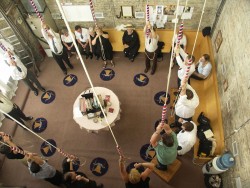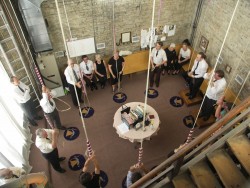 The Bells of Old York in the tower of St. James’ Cathedral at the corner of King and Church Streets are very much part of Toronto’s increasingly rich musical environment. On Sunday mornings, they ring out at 10:00 for an hour before the morning service, each bell turning full circle on a wheel, handled by a live person controlling it at the end of a very long rope – imagine Quasimodo! The band of ringers does not ring a recognizable musical tune. Instead, they ring methods or ring the changes, a centuries old skill developed in England in the 16th century which continues today in church towers there and around the world.
The Bells of Old York in the tower of St. James’ Cathedral at the corner of King and Church Streets are very much part of Toronto’s increasingly rich musical environment. On Sunday mornings, they ring out at 10:00 for an hour before the morning service, each bell turning full circle on a wheel, handled by a live person controlling it at the end of a very long rope – imagine Quasimodo! The band of ringers does not ring a recognizable musical tune. Instead, they ring methods or ring the changes, a centuries old skill developed in England in the 16th century which continues today in church towers there and around the world.
The steeple in St. James housed the only set of 12 bells in North America until Trinity Church on Wall Street in New York installed a ring of 12 about three years ago. St. James’ is, in fact, the only tower with working change-ringing bells in Ontario. Our nearest neighbours are in Quebec City. The twelve bells were installed in 1997 and are named after Anglican churches in the St. James’ diocese. The smallest weighs 631 pounds, the largest 2418 pounds. We know that the tower had been designed originally for change-ringing bells in 1874 but, legend has it that the original bells were sunk in the St. Lawrence on their way to Toronto and have yet to be found. The current bells came from St. James’ Church in Bermondsey in east London close to Tower Bridge.
A band of enthusiastic ringers was recruited all of whom tried and are still trying to master the complicated art of change ringing. Essentially, this means that at every stroke, the order of the bells changes; the bells ring out in sequences and each sequence is different, making it necessary for the ringer to learn the ‘method’ ahead of time in order to keep the rhythm going. According to a sign in the tower, if all possible changes were rung on our 12 bells, in other words, not ringing the same order twice in a row, there would be 479,001,600 changes which would take the ringers 23 years ringing day and night! However keen we are, this feat is very unlikely of course, but peals (3 ½ hours) and quarter-peals (45 minutes) are rung regularly with the help of visiting ringers from all over the world. The bonus of bell ringing is that, once you have learned how to handle a bell, a ringer is welcome in over 5,500 towers world-wide (mostly in England, but also Australia, the U.S. and the eight towers across Canada). You will be invited to, as they say, hang on and have a ring! Although in a Christian church setting, bell ringing has always been considered a secular activity. In some ancient churches in England, access to the tower was deliberately built on the outside of the church in order that the ringers did not disturb the religious service after Sunday ringing. Common practice was for the ringers to repair to the local pub for a pint of beer. As an exercise, ringing can be quite a work-out both physically and mentally. There are no specific skills needed just a love for the magical sound of the bells, enthusiasm and a willingness to practice once a week to improve bell striking and learn the methods.
Although in a Christian church setting, bell ringing has always been considered a secular activity. In some ancient churches in England, access to the tower was deliberately built on the outside of the church in order that the ringers did not disturb the religious service after Sunday ringing. Common practice was for the ringers to repair to the local pub for a pint of beer. As an exercise, ringing can be quite a work-out both physically and mentally. There are no specific skills needed just a love for the magical sound of the bells, enthusiasm and a willingness to practice once a week to improve bell striking and learn the methods.
Our bells were featured in the Toronto Suite composed by David Macfarlane which debuted in October last year and we still hope to ring for the 1812 overture together with the Royal Regiment band one day so that everyone can enjoy the glorious sound of the Bells of Old York ringing out loud and clear in a different way.
Meantime, everyone is welcome to visit us in the tower. We will be taking part in Doors Open Toronto on Saturday May 29 from 10 a.m. So come and visit us. Apart from the fact that we love to show people how beautiful the bells are and how glorious they sound, we are always looking for apprentices to learn this ancient art. For more information please contact: Judith Hunt, Secretary at judithhunt@rogers.com.



